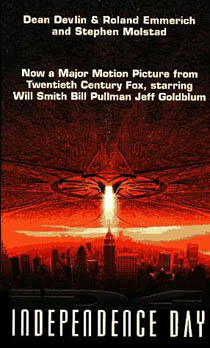To celebrate the 20th anniversary of “Independence Day” and the release of the sequel, “Resurgence,” this week I’m looking back at the various spinoff comics and novels. All of these spin-off materials were recently released (or re-released, in the case of the old stuff) by Titan Books. Also, check out my reviews of “Independence Day” and “Independence Day: Resurgence.”
Stephen Molstad’s “Independence Day” novelization (1996) is a prime example of why we like to read novelizations: It has some scenes that were excised or changed before the final draft, it features “deleted” scenes and it fleshes out more of the story’s details. “ID4” is maligned in some circles for having plot holes or illogical moments, and many of those problems are assuaged in Molstad’s book.
The biggest criticism of “ID4,” of course, is whether David uploading a virus into the alien spaceship has any basis in logic or reason. A perusal of web writings on the subject shows the consensus is that it does not make any logical sense. While Molstad adds some additional mumbo-jumbo about things such as a “wattage booster/power transformer,” I didn’t get much more of a grasp on how the uploading of the virus worked, and I doubt people with serious computer knowledge will be swayed. (But it’s still far more believable than the cloning of dinosaurs in “Jurassic Park,” which rarely gets criticized.)
The biggest divergent scene is that Russell Casse flies his old biwing cropduster, rather than a modern fighter jet, into the city destroyer. The filmmakers made the change because the biwing looked silly when they were compiling the special effects. Another nice advantage to the script change is that it added Casse’s background as a Vietnam War pilot, which makes him a more sympathetic character.
Although there’s not much doubt in the film that Casse was indeed abducted by aliens, Molstad makes it explicitly clear with a flashback of the abduction. As in Marvel Comic’s Issue 0, which became apocryphal almost as soon as it was published, Casse is abducted in 1986. In the comic, though, he’s beamed up from his biplane, whereas in the novel, he’s visited by an eebie while working in his hangar.
Molstad adds another wrinkle where Casse sees the large alien that Hiller had been dragging across the desert and thinks it’s a different species than the smaller ones that abducted him. We don’t get a scene of Russell being informed that the small aliens live inside the larger shells, thus creating a bit of a plot hole exclusive to the book.
The second major point of departure is that Dr. Okun dies in the book, whereas he merely appears to be dead in the film. In the DVD commentary, the filmmakers note that Major Mitchell’s line “He’s dead” was taken out so they’d have the option of bringing Okun back in the sequel (which they did).
The third major difference is that when President Whitmore asks the alien what they want us to do, instead of saying “Die!,” as in the movie, the alien telepathically gives the president a vision of its race’s history of conquering planets, using up all its resources, then moving on to the next planet. This ties in more emphatically with “ID4’s” conservationist theme – of which David Levinson is pretty much the lone adherent – although one can see why “Die!” played better on film.

The most interesting deleted scene is one where Jasmine, as she’s driving the truck across the L.A. ruins and picking up survivors, encounters a rifle-toting gang who murders the preacher. Jasmine gets the gun away from the leader, fires a bullet past his ear — noting that she’s from Alabama and she knows how to use the weapon — and encourages the gang to run off.
Deleting this scene was thematically important, because in the film, the only human villain is nuclear-warfare enthusiast Nimziki, and even he is symbolically redeemed when he joins Julius’ prayer circle. By excising the gunmen who attack Jasmine, “ID4’s” theme of all humanity coming together against a common foe is more crystalized. Yes, it makes the film more simplistic, but I don’t mind the choice to lean toward a feel-good message. (For a franchise about humanity coming together that also shows rogue humans in the mix, we have the “Terminator” saga.)
Because Molstad provides so many more details about the worldwide war than the film does, the book’s sense of celebration is muted somewhat. For example, the film suggests that Houston is abandoned when the nuclear bomb goes off, but the book tells us it is 90 percent evacuated. That means, strictly speaking, that the U.S. military kills about 400,000 civilians with a nuclear bomb. Granted, the city destroyer would have murdered them anyway, but it’s still a harrowing bit of information that the film glosses over.
Molstad concludes the book with an epilogue about how the human race has passed from adolescence to adulthood thanks to the invasion, collectively realizing that all the inter-human conflicts were “petty foolishness.” Again, it’s a simple feel-good message, and an unlikely scenario (there would definitely be reconstruction squabbles among nations), but it’s the point of the franchise, so I guess we have to take it or leave it.
And lest there was ever any doubt that Devlin and Emmerich always had a sequel in mind, Molstad notes that “The world would have to prepare for the possibility of a similar invasion in the future.”

